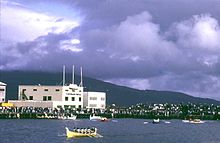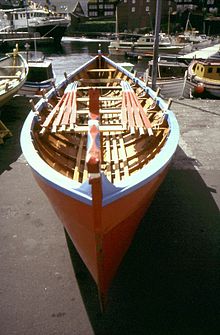Ólavsøka
The ólavsøka [ ɔulavs.øka ] since the 13th century, the National Day of the Faroe Islands on July 28 and particularly on July 29 . It takes its name from the Norwegian King Olav Haraldsson , the saint († July 29, 1030 ). It is a Christian holiday, Parliament opening day, sporting event and folk festival.
In German, this day is also known as Sankt-Olaf's Day or Olavsfest . The Danish expression Olai or Olaifest is also common . Ólavsøka is the Faroese form of the Latin vigilia sancti Olavi (Latin vigilia = Faroese vøka and means watch). Only in the Faroe Islands is the Olav Festival still an integral part of the calendar.
The Ólavsøka will officially open on July 28th at 2 p.m. local time and will end on July 29th at midnight with a common singing of folk songs. Since Ólavsøka is in the middle of the high season, it is also a special tourist attraction. Hotels are usually fully booked six months in advance.
Rowing regatta
The rowing competitions in Tórshavn take place in the afternoon on July 28th . This regatta marks the end of the rowing season for the national championship. The port of Torshavn is lined with crowds, and the boats fighting for the prestige of their location.
Opening of parliament and church convention
Ólavsøka is always the day of the opening ceremony of the Faroese parliament, the Løgting on July 29th, with the previous procession of political, administrative and spiritual dignitaries to Tórshavn Cathedral . The Løgmaður holds the opening of parliament, the State of the Nation , in which he presents the political visions for the coming parliamentary year.
The Evangelical Lutheran Faroese People's Church holds its annual convention on July 29th after the joint church visit in the bishopric, to which all pastors of the country appear.
Folk festival
Tórshavn is the ólavsøka scene of the biggest public festival of the Faroese . People flock to the capital from everywhere. Since 2003, there have also been Ólavsøka celebrations by foreign Faroes in Copenhagen who fail to go to Tórshavn. Otherwise, Tórshavn is the only place where Ólavsøka is celebrated.
The Faroese flag is hoisted everywhere and many people wear the Faroese traditional costume . There will Faroese chain dance to old ballads instead.
At the same time there is the Ólavsøkufestival with contemporary popular music by Faroese artists. There is also an annual exhibition of Faroese art .
The festivities end at midnight on July 29th each year, when thousands of people gather in the market square in Tórshavn and the adjacent streets to sing old and new folk songs together for an hour. There are extra singing books for this.
A greeting to Ólavsøka in Faroese is Góða ólavsøku! (Good Ólavsøka!)
Meaning of Olav the Saint for the Faroese
Although Ólavsøka is the most important day in the Faroese calendar, there is no street or place named after Olav the Saint. He was never personally on the islands. He was even downright unpopular there during his lifetime because of the high tax burden he placed on the Faroese. Tradition says (jokingly) that this is the reason why there is no forest in the Faroe Islands.

